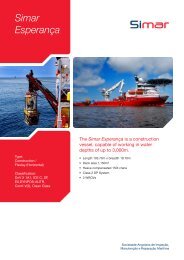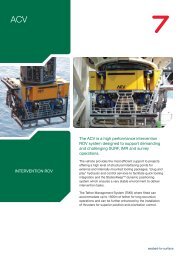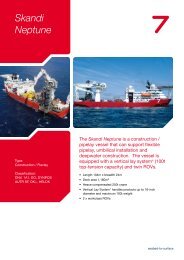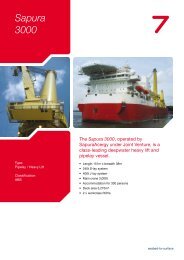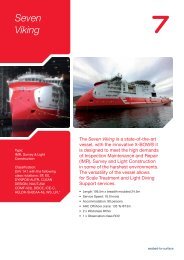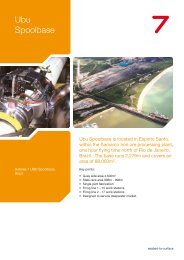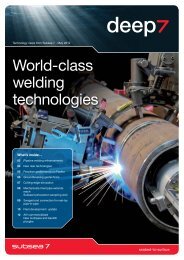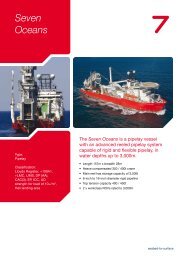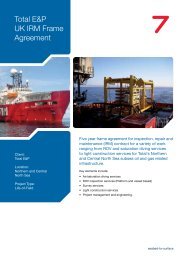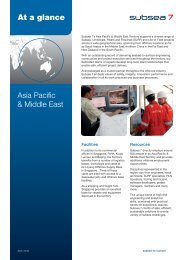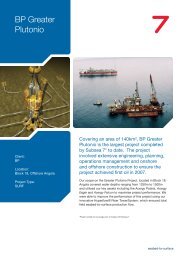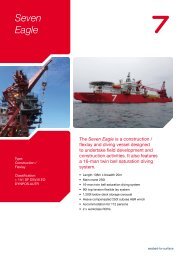Deep 7 - May 2013 - Subsea 7
Deep 7 - May 2013 - Subsea 7
Deep 7 - May 2013 - Subsea 7
Create successful ePaper yourself
Turn your PDF publications into a flip-book with our unique Google optimized e-Paper software.
Gateway to the Arctic<br />
<strong>Subsea</strong> 7 has established its Arctic research competency in<br />
St. John’s, Newfoundland and Labrador, whose icy offshore<br />
environment is classified as sub-Arctic.<br />
Although not as challenging as the Arctic, the basins off the<br />
coast of Newfoundland, where current oil and gas resources are<br />
being exploited, have harsh metocean and ice conditions that<br />
are continuously changing. From intense winter storms to sea<br />
ice and icebergs in the spring, and heavy fog in the summer,<br />
this unique combination of environmental conditions has made<br />
the development of offshore energy resources very challenging.<br />
St. John’s, often referred to as the “Gateway to the Arctic”,<br />
is already the focal point for offshore resource development<br />
in Canada, leading to the widespread establishment of Arctic<br />
research facilities in the area.<br />
The sub-Arctic technology<br />
solutions developed in<br />
St. John’s are likely to<br />
be transferable to more<br />
difficult Arctic regions as<br />
offshore development<br />
moves further north,<br />
and <strong>Subsea</strong> 7 is already<br />
working in collaboration with operator clients, local Arctic<br />
experts and dedicated research facilities toward identifying<br />
targeted Arctic challenges and developing research and<br />
technology development programmes to meet them.<br />
For further information contact Dwayne.Hopkins@subsea7.com<br />
Simultaneous dual pipeline<br />
installation<br />
An innovative process which allows for the<br />
simultaneous pipelay of a flexible pipe or cable<br />
attached onto a more robust carrier pipe has<br />
been developed by <strong>Subsea</strong> 7 and successfully<br />
deployed for the first time in the harsh waters<br />
West of Shetland, where weather dependency<br />
is a major limiting factor to efficient pipelay<br />
operations.<br />
The conventional process for such an operation<br />
is “piggybacking”, a labour-intensive process<br />
involving manual blocks and banding procedures,<br />
which typically restrict pipe-laying speed.<br />
In 2011, <strong>Subsea</strong> 7 first started work on developing<br />
a more efficient and safer solution – a semiautomatic<br />
process where operators did not<br />
have to work in close proximity to the moving<br />
pipelines, and where accelerated lay-rates would<br />
be possible.<br />
This new system made its operational debut on<br />
Total’s 142km Laggan-Tormore pipeline in 2012,<br />
on which Seven Oceans applied over 30,000 of<br />
the new clamps without impacting on the pipelay<br />
rate.<br />
It is recognised that conventional banding<br />
has significant limitations for fast, automatic<br />
piggybacking, so, after detailed study of the<br />
installation and operational conditions, the<br />
developers decided to trial a semi-automatic<br />
machine which would simultaneously align the<br />
two pipes together and apply a new quick-locking<br />
block concept.<br />
After intensive testing of the prototype clamps, a suitable material for the<br />
blocks was identified – a tough, inert, water-resistant plastic. A design<br />
was developed by which the two halves of the block could be quickly<br />
locked around the pipes by six quick-fastening, barbed stainless steel<br />
fixings.<br />
The new system has a number of advantages – it is quick to apply, and<br />
can cater for a wide range of pipe diameters.<br />
The robustness of the design is also advantageous when pipelines are<br />
pulled through a long conduit, as was the case with Laggan-Tormore.<br />
This procedure can damage conventional banding, but no piggyback<br />
clamps were lost during the system’s inaugural deployment.<br />
For further information contact Lee.Rolf@subsea7.com<br />
www.subsea7.com<br />
DEEP7 <strong>May</strong> <strong>2013</strong><br />
© <strong>Subsea</strong> 7, <strong>2013</strong>. Information correct at time of going to press.



